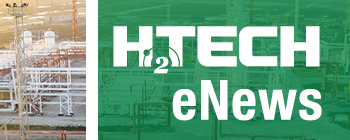News
Wärtsilä, Höegh Evi and partners complete development of floating ammonia-to-H2 cracker
Wärtsilä Gas Solutions, part of technology group Wärtsilä, and Höegh Evi, a global leader in marine energy infrastructure, have successfully completed development of the world’s first floating ammonia-to-H2 cracker. This breakthrough technology enables floating import terminals to produce H2 at industrial-scale volumes from transported ammonia, marking a major step in the energy transition. The project was announced in April 2023 and is part of Norway’s green platform program.
The industrial-scale ammonia cracker has a modular design that allows integration into both hybrid floating storage and regasification units (FSRUs) and dedicated floating H2 terminals.
The technology is highly scalable with a send out capacity of up to 210,000 tpy of H2. Ammonia storage can range from 10,000 m³ to 120,000 m³.
"The floating ammonia-to-H2 cracker developed by Höegh Evi, Wärtsilä Gas Solutions and partners is a game-changer for the H2 economy and the energy transition in Europe. Our floating terminals and cracking technology can unlock the full potential of global value chains for green H2, providing European industry with a reliable supply of clean energy within this decade," said Erik Nyheim, CEO of Höegh Evi.
"This pioneering development of the floating ammonia-to-H2 cracker represents a significant leap forward in our quest for sustainable energy solutions. Together with Höegh Evi and our partners, we are not only addressing the challenges of H2 storage and transportation but also paving the way for a more resilient and flexible energy infrastructure," said Kjell Ove Ulstein, Sales & Marketing Director, Wärtsilä Gas Solutions.
The project has received approximately €5.9 MM in funding from the Norwegian Government’s green platform program, representing approximately 50% of the total budget. The ammonia cracker was constructed at Sustainable Energy’s Norwegian Catapult Center in Stord, Norway. Additional partners in the project include the Institute for Energy Technology (IFE), University of South-East Norway, Sustainable Energy and BASF SE.
"The future of energy must be green, and it’s our job to be part of the technological development necessary to achieve this goal. We are very happy for this project," said Håkon Haugli, CEO of Innovation Norway.
Innovation Norway is the Norwegian trade promotion organization and is partly responsibility for the allocation of funds within the Green Platform program.
According to the EU’s REPower strategy, Europe plans to import 10 MMtpy of renewable H2 by 2030. As the development of the H2 grid progresses, floating infrastructure with ammonia cracking technology can unlock large-scale imports, supplying hard-to-abate industries with a stable baseload energy source and balance within the energy system.
H2 is emerging as a viable sustainable fuel in the move away from fossil fuels and can be produced at a relatively low cost in countries where there is ample access to renewable power. However, it is difficult to store and transport H2, due to its low volumetric energy density and with potentially large vaporization losses. Ammonia is significantly better suited than H2 for this purpose. It can be stored in liquid form at moderate pressures and temperatures and transported over long distances by ship. When it arrives at the receiving destination, the ammonia cracker will convert the ammonia back to H2 for distribution into the core energy grid.

